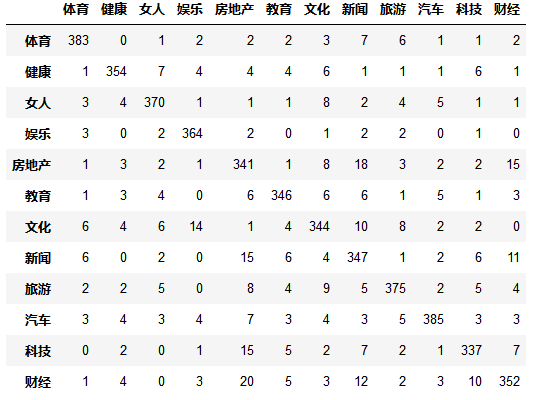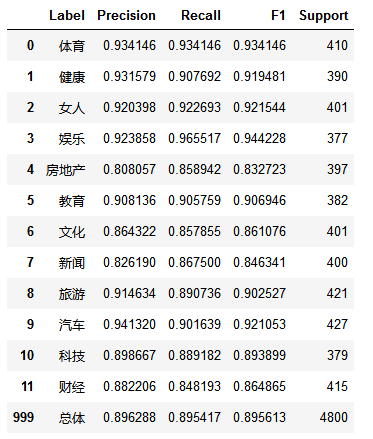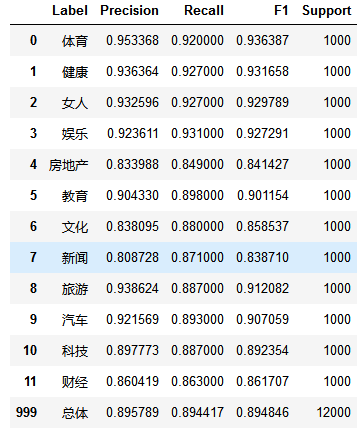基于jieba,TfidfVectorizer,LogisticRegression进行搜狐新闻文本分类
一、简介
此文是对利用jieba,word2vec,LR进行搜狐新闻文本分类的准确性的提升,数据集和分词过程一样,这里就不在叙述,读者可参考前面的处理过程
经过jieba分词,产生24000条分词结果(sohu_train.txt有24000行数据,每行对应一个分词结果)
with open('cutWords_list.txt') as file:
cutWords_list = [ k.split() for k in file ]

1)TfidfVectorizer模型
调用sklearn.feature_extraction.text库的TfidfVectorizer方法实例化模型对象。TfidfVectorizer方法4个参数含义:
- 第1个参数是分词结果,数据类型为列表,其中的元素也为列表
- 第2个关键字参数stop_words是停顿词,数据类型为列表
- 第3个关键字参数min_df是词频低于此值则忽略,数据类型为int或float
- 第4个关键字参数max_df是词频高于此值则忽略,数据类型为int或float
from sklearn.feature_extraction.text import TfidfVectorizer
tfidf = TfidfVectorizer(cutWords_list, stop_words=stopword_list, min_df=40, max_df=0.3)
2)特征工程
X = tfidf.fit_transform(train_df['文章'])
print('词表大小', len(tfidf.vocabulary_))
print(X.shape)
可见每篇文章内容被向量化,维度特征时3946

3)模型训练
3.1)LabelEncoder
from sklearn.preprocessing import LabelEncoder
import pandas as pd
train_df = pd.read_csv('sohu_train.txt', sep='\t', header=None) labelEncoder = LabelEncoder()
y = labelEncoder.fit_transform(train_df[0])#一旦给train_df加上columns,就无法使用[0]来获取第一列了
y.shape

3.2)逻辑回归
from sklearn.linear_model import LogisticRegression
from sklearn.model_selection import train_test_split train_X, test_X, train_y, test_y = train_test_split(X, y, test_size=0.2)
logistic_model = LogisticRegression(multi_class = 'multinomial', solver='lbfgs')
logistic_model.fit(train_X, train_y)
logistic_model.score(test_X, test_y)
其中逻辑回归参数官方文档:http://scikit-learn.org/stable/modules/generated/sklearn.linear_model.LogisticRegression.html

3.3)保存模型
调用pickle:pip install pickle
第1个参数是保存的对象,可以为任意数据类型,因为有3个模型需要保存,所以下面代码第1个参数是字典
第2个参数是保存的文件对象
import pickle
with open('tfidf.model', 'wb') as file:
save = {
'labelEncoder' : labelEncoder,
'tfidfVectorizer' : tfidf,
'logistic_model' : logistic_model
} pickle.dump(save, file)
3.4)交叉验证
在进行此步的时候,不需要运行此步之前的所有步骤,即可以重新运行jupyter notebook。然后调用pickle库的load方法加载保存的模型对象,代码如下:
import pickle
with open('tfidf.model', 'rb') as file:
tfidf_model = pickle.load(file)
tfidfVectorizer = tfidf_model['tfidfVectorizer']
labelEncoder = tfidf_model['labelEncoder']
logistic_model = tfidf_model['logistic_model']
load模型后,重新加载测试集:
import pandas as pd
train_df = pd.read_csv('sohu_train.txt', sep='\t', header=None)
X = tfidfVectorizer.transform(train_df[1])
y = labelEncoder.transform(train_df[0])
调用sklearn.linear_model库的LogisticRegression方法实例化逻辑回归模型对象。
调用sklearn.model_selection库的ShuffleSplit方法实例化交叉验证对象。
调用sklearn.model_selection库的cross_val_score方法获得交叉验证每一次的得分。
最后打印每一次的得分以及平均分,代码如下:
from sklearn.linear_model import LogisticRegression
from sklearn.model_selection import ShuffleSplit
from sklearn.model_selection import cross_val_score logistic_model = LogisticRegression(multi_class='multinomial', solver='lbfgs')
cv_split = ShuffleSplit(n_splits=5, test_size=0.3)
score_ndarray = cross_val_score(logistic_model, X, y, cv=cv_split)
print(score_ndarray)
print(score_ndarray.mean())

4)模型评估
绘制混淆矩阵:
from sklearn.model_selection import train_test_split
from sklearn.linear_model import LogisticRegressionCV
from sklearn.metrics import confusion_matrix
import pandas as pd
train_X, test_X, train_y, test_y = train_test_split(X, y, test_size=0.2)
logistic_model = LogisticRegressionCV(multi_class='multinomial', solver='lbfgs')
logistic_model.fit(train_X, train_y)
predict_y = logistic_model.predict(test_X) pd.DataFrame(confusion_matrix(test_y, predict_y),columns=labelEncoder.classes_, index=labelEncoder.classes_)

绘制precision、recall、f1-score、support报告表:
import numpy as np
from sklearn.metrics import precision_recall_fscore_support def eval_model(y_true, y_pred, labels):
#计算每个分类的Precision, Recall, f1, support
p, r, f1, s = precision_recall_fscore_support( y_true, y_pred)
#计算总体的平均Precision, Recall, f1, support
tot_p = np.average(p, weights=s)
tot_r = np.average(r, weights=s)
tot_f1 = np.average(f1, weights=s)
tot_s = np.sum(s)
res1 = pd.DataFrame({
u'Label': labels,
u'Precision' : p,
u'Recall' : r,
u'F1' : f1,
u'Support' : s
}) res2 = pd.DataFrame({
u'Label' : ['总体'],
u'Precision' : [tot_p],
u'Recall': [tot_r],
u'F1' : [tot_f1],
u'Support' : [tot_s]
}) res2.index = [999]
res = pd.concat( [res1, res2])
return res[ ['Label', 'Precision', 'Recall', 'F1', 'Support'] ] predict_y = logistic_model.predict(test_X)
eval_model(test_y, predict_y, labelEncoder.classes_)

5)模型测试
import pandas as pd
test_df = pd.read_csv('sohu_test.txt', sep='\t', header=None)
test_X = tfidfVectorizer.transform(test_df[1])
test_y = labelEncoder.transform(test_df[0])
predict_y = logistic_model.predict(test_X)
eval_model(test_y, predict_y, labelEncoder.classes_)

6)总结
训练集数据共有24000条,测试集数据共有12000条。经过交叉验证,模型平均得分为0.8711
模型评估时,使用LogisticRegressionCV模型,得分提高了3%,为0.9076
最后在测试集上的f1-score指标为0.8990,总体来说这个分类模型较优秀,能够投入实际应用
7)致谢
本文参考简书:https://www.jianshu.com/p/96b983784dae
感谢作者的详细过程,再次感谢!
8)流程图

基于jieba,TfidfVectorizer,LogisticRegression进行搜狐新闻文本分类的更多相关文章
- 利用jieba,word2vec,LR进行搜狐新闻文本分类
一.简介 1)jieba 中文叫做结巴,是一款中文分词工具,https://github.com/fxsjy/jieba 2)word2vec 单词向量化工具,https://radimrehurek ...
- sohu_news搜狐新闻类型分类
数据获取 数据是从搜狐新闻开放的新闻xml数据,经过一系列的处理之后,生成的一个excel文件 该xml文件的处理有单独的处理过程,就是用pandas处理,该过程在此省略 import numpy a ...
- 使用百度NLP接口对搜狐新闻做分类
一.简介 本文主要是要利用百度提供的NLP接口对搜狐的新闻做分类,百度对NLP接口有提供免费的额度可以拿来练习,主要是利用了NLP里面有个文章分类的功能,可以顺便测试看看百度NLP分类做的准不准.详细 ...
- 【NLP】3000篇搜狐新闻语料数据预处理器的python实现
3000篇搜狐新闻语料数据预处理器的python实现 白宁超 2017年5月5日17:20:04 摘要: 关于自然语言处理模型训练亦或是数据挖掘.文本处理等等,均离不开数据清洗,数据预处理的工作.这里 ...
- 利用朴素贝叶斯分类算法对搜狐新闻进行分类(python)
数据来源 https://www.sogou.com/labs/resource/cs.php介绍:来自搜狐新闻2012年6月—7月期间国内,国际,体育,社会,娱乐等18个频道的新闻数据,提供URL ...
- 搜狗输入法弹出搜狐新闻的解决办法(sohunews.exe)
狗输入法弹出搜狐新闻的解决办法(sohunews.exe) 1.找到搜狗输入法的安装目录(一般是C:\program files\sougou input\版本号\)2.右键点击sohunews.ex ...
- 利用搜狐新闻语料库训练100维的word2vec——使用python中的gensim模块
关于word2vec的原理知识参考文章https://www.cnblogs.com/Micang/p/10235783.html 语料数据来自搜狐新闻2012年6月—7月期间国内,国际,体育,社会, ...
- 搜狐新闻APP是如何使用HUAWEI DevEco IDE快速集成HUAWEI HiAI Engine
6月12日,搜狐新闻APP最新版本在华为应用市场正式上线啦! 那么,这一版本的搜狐新闻APP有什么亮点呢? 先抛个图,来直接感受下—— 模糊图片,瞬间清晰! 效果杠杠的吧. 而藏在这项神操作背后的 ...
- 世界更清晰,搜狐新闻客户端集成HUAWEI HiAI 亮相荣耀Play发布会!
6月6日,搭载有“很吓人”技术的荣耀Play正式发布,来自各个领域的大咖纷纷为新机搭载的惊艳技术站台打call,其中,搜狐公司董事局主席兼首席执行官张朝阳揭秘:华为和搜狐新闻客户端在硬件AI方面做 ...
随机推荐
- Springboot学习问题记录
1.spring boot与cloud构建微服务,返回数据从json变成了xml 问题:本身spingboot项目是用@RestController注解,返回结果也是json格式,但是结合spring ...
- 【NLP】Recurrent Neural Network and Language Models
0. Overview What is language models? A time series prediction problem. It assigns a probility to a s ...
- 【C/C++】动态内存分配和链表
本文对链表以及C/C++中的动态链表做详细诠释. 什么是链表? 链表是一种重要的数据结构,它最大的优点是可以进行动态的存储分配.链表有单向链表,双向链表,循环链表.对于c,这里我们只讨论单向链表. 我 ...
- Android与H5交互 原理与对比
原文: https://www.jianshu.com/p/345f4d8a5cfa 1.Android调用JS的方法有2种: (1)通过WebView的loadUrl() // 调用js中的函数: ...
- Siki的虚幻第一季
空项目.一闪而过的解决方法 命名空间std::cout的作用: int ,long , long long类型的范围 unsigned int 0-4294967295 int 21474 ...
- iptables(3)
----------------------------iptables企业应用 ****************************单机防火墙列表#!/bin/bash#============ ...
- default.conf
1./etc/nginx/conf.d/ 下设置一个 default.conf,server_name 设置为 localhost,如果有其他非法域名 A 记录到该机器上,则返回默认的 Nginx 页 ...
- Nginx加载模块
1. /usr/local/nginx/sbin/nginx -V 查看nginx版本与编译安装了哪些模块nginx version: nginx/1.10.3built by gcc 4.4.7 2 ...
- [ZJOI2010]贪吃的老鼠(网络流+建图)
题目描述 奶酪店里最近出现了m只老鼠!它们的目标就是把生产出来的所有奶酪都吃掉.奶酪店中一天会生产n块奶酪,其中第i块的大小为pi,会在第ri秒被生产出来,并且必须在第di秒之前将它吃掉.第j只老鼠吃 ...
- layui laydate is not defined
记得引入的js文件要放到layui.js前面才会生效
